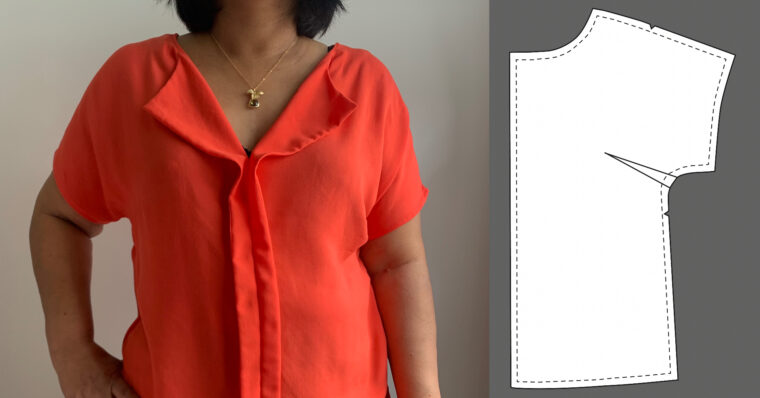Neha from the Advisors Circle has created an easy-to-follow small bust adjustment tutorial. Our newer patterns all include cup sizes so that you don’t need to adjust them. But if you find that other sewing patterns are usually too large in the bust, a small bust adjustment can help you perfect the fit. Take it away, Neha!
Do you have a garment that looks baggy or ill-fitting in the chest area? If so, you may benefit from doing a small bust adjustment (SBA).
When a pattern cup size is larger than your sewing cup size, the garment results in excess fabric in the chest area. An SBA removes this excess. This adjustment is good for both fitted as well as semi-fitted garments, resulting in a better fitting make.
If you are unsure of your sewing cup size, measure your high bust and full bust. The high bust measurement is the distance around your chest above your bust, right under your armpits. The full bust measurement goes around the fullest point of your bust. The difference between the full bust and high bust determines your sewing cup size. AA cup =1/2″ or none, A cup = 1″, B cup = 2″, C cup = 3″, etc.
I recently made a Weekend Getaway Blouse, which is drafted for a B cup. I am an A cup, so doing an SBA helped me get the desired fit. Here’s a tutorial for my small bust adjustment method.
How to do a small bust adjustment
Step 1: Draw a vertical line (line A on the illustration) parallel to the pattern center front from the shoulder to the hemline such that it intersects the tip of the dart.
Step 2: Draw a second vertical line (line B on the illustration) parallel to line A. Draw this line between line A and the center front, away from the dart. The distance of line B from line A will be half the amount of your total bust adjustment. So, to make a 1″ small bust adjustment, draw line B 1/2” from line A. For a 1/2″ adjustment, draw the line 1/4″ from line A.
Step 3: Cut line A starting from the hemline up to the shoulder seam line but not through it (marked by circle 1 on the illustration). This will act as a ‘hinge’ to pivot and alter the pattern.
Step 4: Cut the top leg of the dart (line C on the illustration above) from the side all the way to the tip of the dart but not through it (marked by circle 2 on the illustration). This will act as a hinge to pivot and alter the dart.
Step 5: Carefully slide the cut pattern piece such that line A meets line B from the tip of the dart down. The paper will overlap. Tape the overlap.
Step 6: As you manipulate this pattern piece, you will notice that the cut dart line will also pivot along the hinge and overlap the pattern piece. Tape this overlap as well. The cut edge is your new dart line. If the overlap results in a very small dart, you can smoosh the dart out, removing the dart entirely.
Step 7: Even out the side seam by tracing a line from the sleeve hem down the sides to follow the original pattern curve, removing excess overlap.
Step 8: Even out the hemline by tracing a line starting from the side seam corner to the center front line following the original pattern curve.
That’s it. You now have a new pattern piece that’s modified to fit your body!

